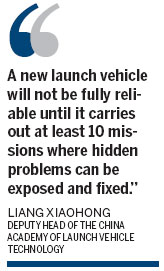Jumbo rocket design poses challenges
Updated: 2013-03-04 07:48
By Xin Dingding (China Daily)
|
||||||||
|
Ethnic groups CPPCC National Committee members pose at the Great Hall of the People in Beijing on Sunday. Zou Hong / China Daily |

Development of Long March-11 to boost ability to enter space
Problems in the development of China's largest rocket have delayed its launch, probably until 2015, said a senior official working on the launch vehicle's design.
The Long March-5 was initially due to be launched next year.
"Our plan has encountered some difficulties," said Liang Xiaohong, deputy head of the China Academy of Launch Vehicle Technology, referring to three failed experiments recently.
The main difficulty lies in the rocket's structural elements, said Liang, who is also a member of the National Committee of the 12th Chinese People's Political Consultative Conference.
Though China's Long March rockets have recorded more than 100 successful launches, the Long March-5 is a new challenge due to its larger size - a diameter of 5 meters, instead of the 3.35 meters of all previous launch vehicles.
The larger design enables the Long March-5 to send heavy satellites and space station components into orbit, and it has six vehicle configurations planned for different missions.
"But when an object is bigger, its technical risks and functional defects are also magnified," Liang said.
The increased size has challenged the mechanical machining capabilities of Chinese manufacturers, who have never produced rocket parts as big before and lack the necessary equipment and technology, he added.
"The Long March-5 project has reached the basic industry's ceiling," Liang said.
Also, the potential risks of a larger launch vehicle in space are unknown, and the designers must gauge these for six configurations of the craft instead of one, he said.
Failure to solve the problem has prompted the academy to push manufacturers to improve their level of mechanical machining.
However, next year will still see the debut of Long March-7, which is designed to send China's cargo spaceship to dock with a future space station.
The Long March-7 carrier rocket has a takeoff thrust of 700 metric tons, the second-largest after Long March-5 with 1,000 tons.
"Scientists are mulling over the idea of using it to launch a manned spaceship in the future, too," said Liang. "If so, the Long March-7 will become the country's only rocket that can send manned and unmanned spacecraft into space."
The Long March-11 is also in development, China's first launch vehicle using solid fuel, which is expected to make its first launch before 2016.
"The development of Long March-11 will greatly improve China's capabilities to rapidly enter space and meet the demand for emergency launches in case of accidents," he said.
The carrier rocket will be easy to operate and cost-efficient to launch, and it can be stored for long periods to launch at short notice.
"If a major earthquake - like the one that rocked Wenchuan of Sichuan province in 2008 - strikes again, we will be able to quickly send satellites into space that can take photos of the devastated area and help with rescue work," Liang said.
Time to mature
Liang expects the next generation of carrier rockets will operate together with earlier models to serve space missions for the next 10 to 20 years.
"A new launch vehicle will not be fully reliable until it carries out at least 10 missions where hidden problems can be exposed and fixed. Sometimes, even after a model has carried out many missions, deeper technical problems will not emerge until it encounters special situations in space," he said.
Time is also needed for the new generation of launch vehicles to become competitive in cost, too, he added.
By then, China's launch systems will be able to send payloads from 1 to 25 tons into three levels of orbit, ranging from 200 km to 35,000 km altitude, and meet the demands of China's short- and mid-term space programs.
But to meet long-term space goals, China will need to develop a rocket with a takeoff thrust of 3,000 tons, three times that of Long March-5, which will be able to send men to the moon.
Research on a heavy-thrust launch vehicle has been carried out in the past years. Scientists visualize a rocket with a diameter of at least 8 meters, able to send a 100-ton payload into low earth orbit.
The academy aims to have the heavy-thrust rocket project approved by the government under the 12th Five-Year Plan period (2011-15), Liang said.
"If approved, China will stand in the same line as space powers such as the United States and Russia regarding launch vehicles, which is the precondition for all space activities," he said.
xindingding@chinadaily.com.cn
(China Daily 03/04/2013 page5)

 In Photos: 7.0-magnitude quake hits Sichuan
In Photos: 7.0-magnitude quake hits Sichuan
 Li Na on Time cover, makes influential 100 list
Li Na on Time cover, makes influential 100 list
 FBI releases photos of 2 Boston bombings suspects
FBI releases photos of 2 Boston bombings suspects
 World's wackiest hairstyles
World's wackiest hairstyles
 Sandstorms strike Northwest China
Sandstorms strike Northwest China
 Never-seen photos of Madonna on display
Never-seen photos of Madonna on display
 H7N9 outbreak linked to waterfowl migration
H7N9 outbreak linked to waterfowl migration
 Dozens feared dead in Texas plant blast
Dozens feared dead in Texas plant blast
Most Viewed
Editor's Picks

|

|

|

|

|

|
Today's Top News
Live report: 7.0-magnitude quake hits Sichuan, heavy casualties feared
Boston suspect cornered on boat
Cross-talk artist helps to spread the word
'Green' awareness levels drop in Beijing
Palace Museum spruces up
First couple on Time's list of most influential
H7N9 flu transmission studied
Trading channels 'need to broaden'
US Weekly

|

|








